spare wheel FIAT DOBLO COMBI 2017 2.G Owners Manual
[x] Cancel search | Manufacturer: FIAT, Model Year: 2017, Model line: DOBLO COMBI, Model: FIAT DOBLO COMBI 2017 2.GPages: 300, PDF Size: 24.91 MB
Page 139 of 300
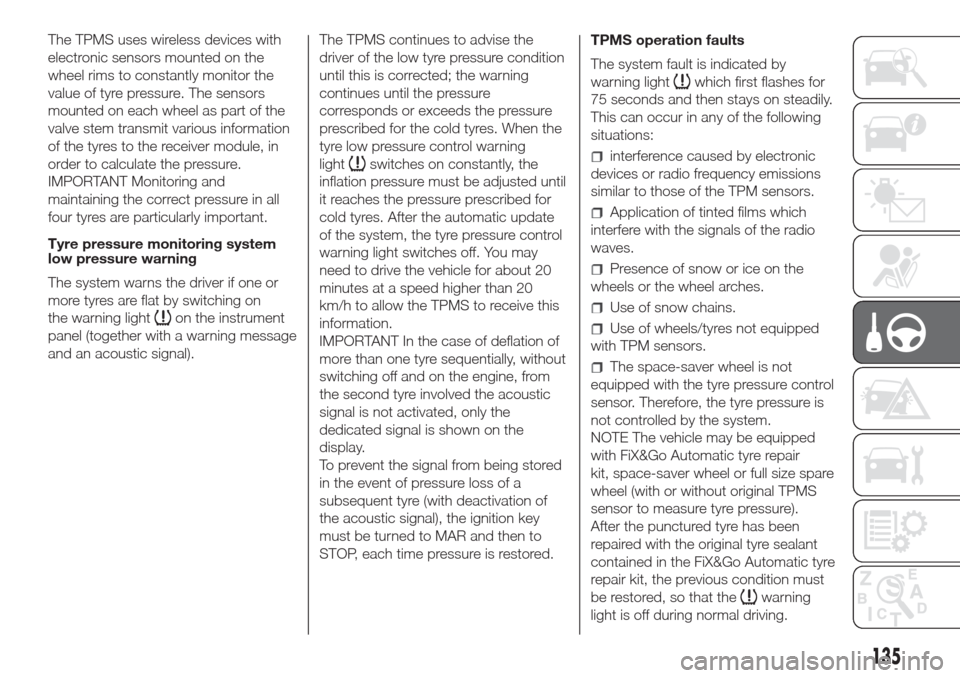
The TPMS uses wireless devices with
electronic sensors mounted on the
wheel rims to constantly monitor the
value of tyre pressure. The sensors
mounted on each wheel as part of the
valve stem transmit various information
of the tyres to the receiver module, in
order to calculate the pressure.
IMPORTANT Monitoring and
maintaining the correct pressure in all
four tyres are particularly important.
Tyre pressure monitoring system
low pressure warning
The system warns the driver if one or
more tyres are flat by switching on
the warning light
on the instrument
panel (together with a warning message
and an acoustic signal).The TPMS continues to advise the
driver of the low tyre pressure condition
until this is corrected; the warning
continues until the pressure
corresponds or exceeds the pressure
prescribed for the cold tyres. When the
tyre low pressure control warning
light
switches on constantly, the
inflation pressure must be adjusted until
it reaches the pressure prescribed for
cold tyres. After the automatic update
of the system, the tyre pressure control
warning light switches off. You may
need to drive the vehicle for about 20
minutes at a speed higher than 20
km/h to allow the TPMS to receive this
information.
IMPORTANT In the case of deflation of
more than one tyre sequentially, without
switching off and on the engine, from
the second tyre involved the acoustic
signal is not activated, only the
dedicated signal is shown on the
display.
To prevent the signal from being stored
in the event of pressure loss of a
subsequent tyre (with deactivation of
the acoustic signal), the ignition key
must be turned to MAR and then to
STOP, each time pressure is restored.TPMS operation faults
The system fault is indicated by
warning light
which first flashes for
75 seconds and then stays on steadily.
This can occur in any of the following
situations:
interference caused by electronic
devices or radio frequency emissions
similar to those of the TPM sensors.
Application of tinted films which
interfere with the signals of the radio
waves.
Presence of snow or ice on the
wheels or the wheel arches.
Use of snow chains.
Use of wheels/tyres not equipped
with TPM sensors.
The space-saver wheel is not
equipped with the tyre pressure control
sensor. Therefore, the tyre pressure is
not controlled by the system.
NOTE The vehicle may be equipped
with FiX&Go Automatic tyre repair
kit, space-saver wheel or full size spare
wheel (with or without original TPMS
sensor to measure tyre pressure).
After the punctured tyre has been
repaired with the original tyre sealant
contained in the FiX&Go Automatic tyre
repair kit, the previous condition must
be restored, so that the
warning
light is off during normal driving.
135
Page 140 of 300
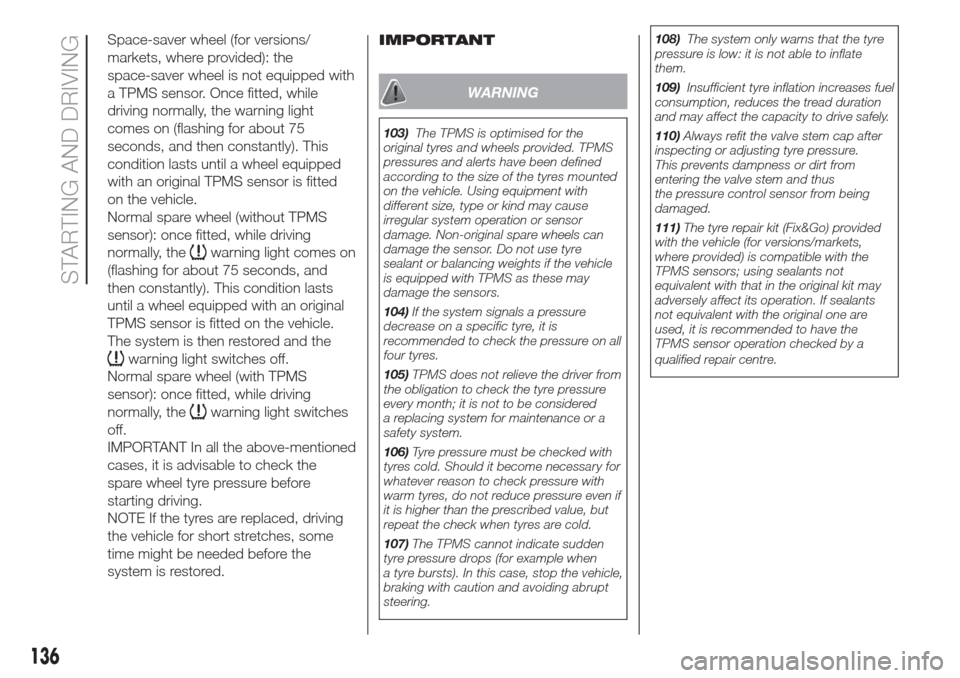
Space-saver wheel (for versions/
markets, where provided): the
space-saver wheel is not equipped with
a TPMS sensor. Once fitted, while
driving normally, the warning light
comes on (flashing for about 75
seconds, and then constantly). This
condition lasts until a wheel equipped
with an original TPMS sensor is fitted
on the vehicle.
Normal spare wheel (without TPMS
sensor): once fitted, while driving
normally, the
warning light comes on
(flashing for about 75 seconds, and
then constantly). This condition lasts
until a wheel equipped with an original
TPMS sensor is fitted on the vehicle.
The system is then restored and the
warning light switches off.
Normal spare wheel (with TPMS
sensor): once fitted, while driving
normally, the
warning light switches
off.
IMPORTANT In all the above-mentioned
cases, it is advisable to check the
spare wheel tyre pressure before
starting driving.
NOTE If the tyres are replaced, driving
the vehicle for short stretches, some
time might be needed before the
system is restored.IMPORTANT
WARNING
103)The TPMS is optimised for the
original tyres and wheels provided. TPMS
pressures and alerts have been defined
according to the size of the tyres mounted
on the vehicle. Using equipment with
different size, type or kind may cause
irregular system operation or sensor
damage. Non-original spare wheels can
damage the sensor. Do not use tyre
sealant or balancing weights if the vehicle
is equipped with TPMS as these may
damage the sensors.
104)If the system signals a pressure
decrease on a specific tyre, it is
recommended to check the pressure on all
four tyres.
105)TPMS does not relieve the driver from
the obligation to check the tyre pressure
every month; it is not to be considered
a replacing system for maintenance or a
safety system.
106)Tyre pressure must be checked with
tyres cold. Should it become necessary for
whatever reason to check pressure with
warm tyres, do not reduce pressure even if
it is higher than the prescribed value, but
repeat the check when tyres are cold.
107)The TPMS cannot indicate sudden
tyre pressure drops (for example when
a tyre bursts). In this case, stop the vehicle,
braking with caution and avoiding abrupt
steering.108)The system only warns that the tyre
pressure is low: it is not able to inflate
them.
109)Insufficient tyre inflation increases fuel
consumption, reduces the tread duration
and may affect the capacity to drive safely.
110)Always refit the valve stem cap after
inspecting or adjusting tyre pressure.
This prevents dampness or dirt from
entering the valve stem and thus
the pressure control sensor from being
damaged.
111)The tyre repair kit (Fix&Go) provided
with the vehicle (for versions/markets,
where provided) is compatible with the
TPMS sensors; using sealants not
equivalent with that in the original kit may
adversely affect its operation. If sealants
not equivalent with the original one are
used, it is recommended to have the
TPMS sensor operation checked by a
qualified repair centre.
136
STARTING AND DRIVING
Page 166 of 300
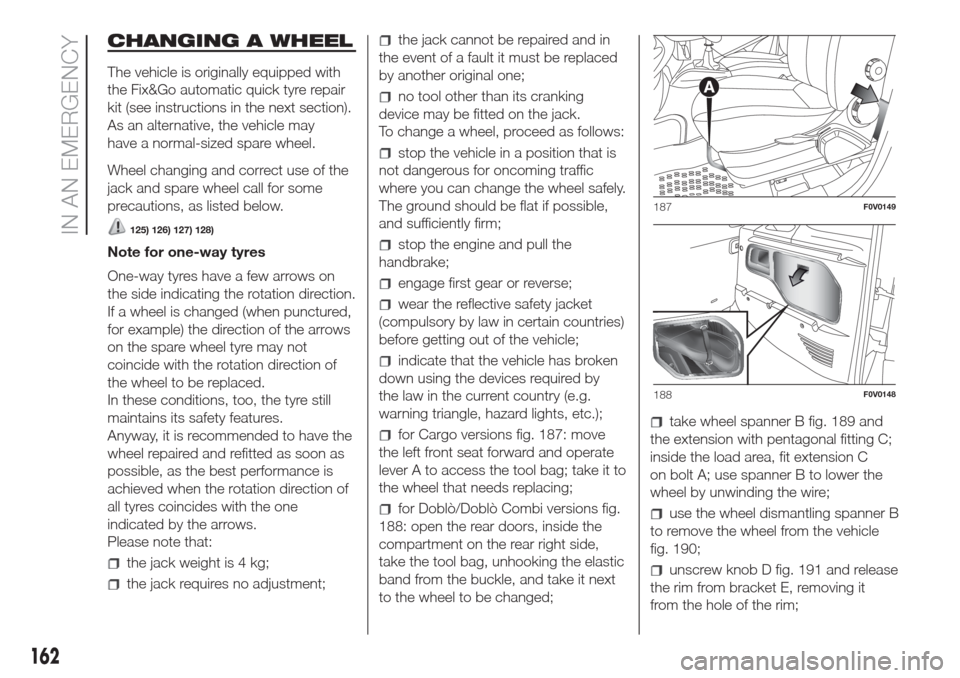
CHANGING A WHEEL
The vehicle is originally equipped with
the Fix&Go automatic quick tyre repair
kit (see instructions in the next section).
As an alternative, the vehicle may
have a normal-sized spare wheel.
Wheel changing and correct use of the
jack and spare wheel call for some
precautions, as listed below.
125) 126) 127) 128)
Note for one-way tyres
One-way tyres have a few arrows on
the side indicating the rotation direction.
If a wheel is changed (when punctured,
for example) the direction of the arrows
on the spare wheel tyre may not
coincide with the rotation direction of
the wheel to be replaced.
In these conditions, too, the tyre still
maintains its safety features.
Anyway, it is recommended to have the
wheel repaired and refitted as soon as
possible, as the best performance is
achieved when the rotation direction of
all tyres coincides with the one
indicated by the arrows.
Please note that:
the jack weight is 4 kg;
the jack requires no adjustment;
the jack cannot be repaired and in
the event of a fault it must be replaced
by another original one;
no tool other than its cranking
device may be fitted on the jack.
To change a wheel, proceed as follows:
stop the vehicle in a position that is
not dangerous for oncoming traffic
where you can change the wheel safely.
The ground should be flat if possible,
and sufficiently firm;
stop the engine and pull the
handbrake;
engage first gear or reverse;
wear the reflective safety jacket
(compulsory by law in certain countries)
before getting out of the vehicle;
indicate that the vehicle has broken
down using the devices required by
the law in the current country (e.g.
warning triangle, hazard lights, etc.);
for Cargo versions fig. 187: move
the left front seat forward and operate
lever A to access the tool bag; take it to
the wheel that needs replacing;
for Doblò/Doblò Combi versions fig.
188: open the rear doors, inside the
compartment on the rear right side,
take the tool bag, unhooking the elastic
band from the buckle, and take it next
to the wheel to be changed;
take wheel spanner B fig. 189 and
the extension with pentagonal fitting C;
inside the load area, fit extension C
on bolt A; use spanner B to lower the
wheel by unwinding the wire;
use the wheel dismantling spanner B
to remove the wheel from the vehicle
fig. 190;
unscrew knob D fig. 191 and release
the rim from bracket E, removing it
from the hole of the rim;
187F0V0149
188F0V0148
162
IN AN EMERGENCY
Page 168 of 300
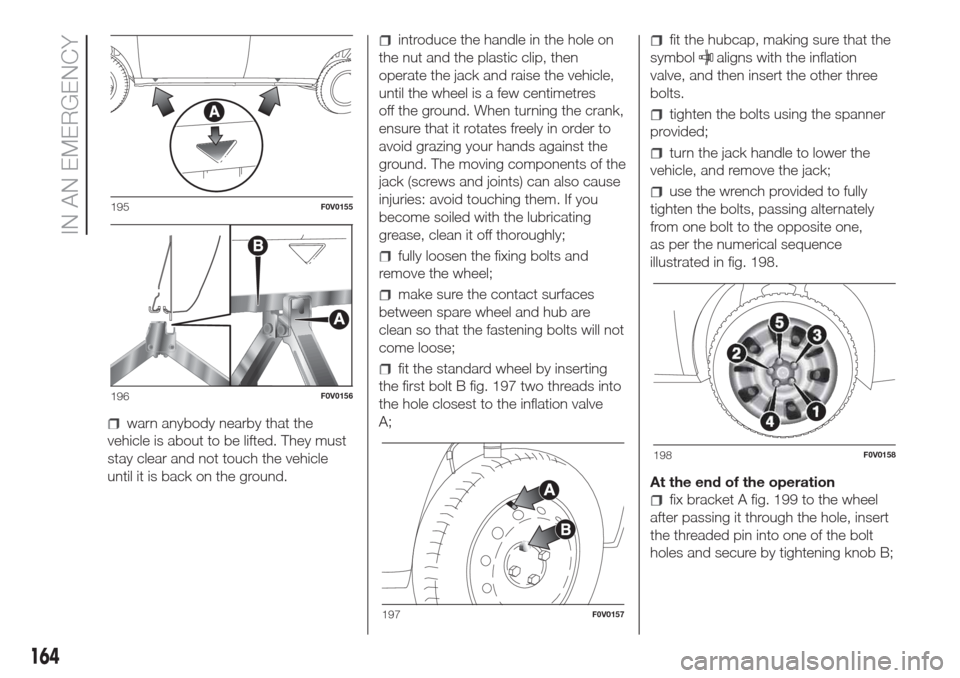
warn anybody nearby that the
vehicle is about to be lifted. They must
stay clear and not touch the vehicle
until it is back on the ground.
introduce the handle in the hole on
the nut and the plastic clip, then
operate the jack and raise the vehicle,
until the wheel is a few centimetres
off the ground. When turning the crank,
ensure that it rotates freely in order to
avoid grazing your hands against the
ground. The moving components of the
jack (screws and joints) can also cause
injuries: avoid touching them. If you
become soiled with the lubricating
grease, clean it off thoroughly;
fully loosen the fixing bolts and
remove the wheel;
make sure the contact surfaces
between spare wheel and hub are
clean so that the fastening bolts will not
come loose;
fit the standard wheel by inserting
the first bolt B fig. 197 two threads into
the hole closest to the inflation valve
A;
fit the hubcap, making sure that the
symbol
aligns with the inflation
valve, and then insert the other three
bolts.
tighten the bolts using the spanner
provided;
turn the jack handle to lower the
vehicle, and remove the jack;
use the wrench provided to fully
tighten the bolts, passing alternately
from one bolt to the opposite one,
as per the numerical sequence
illustrated in fig. 198.
At the end of the operation
fix bracket A fig. 199 to the wheel
after passing it through the hole, insert
the threaded pin into one of the bolt
holes and secure by tightening knob B;
195F0V0155
196F0V0156
197F0V0157
198F0V0158
164
IN AN EMERGENCY
Page 169 of 300
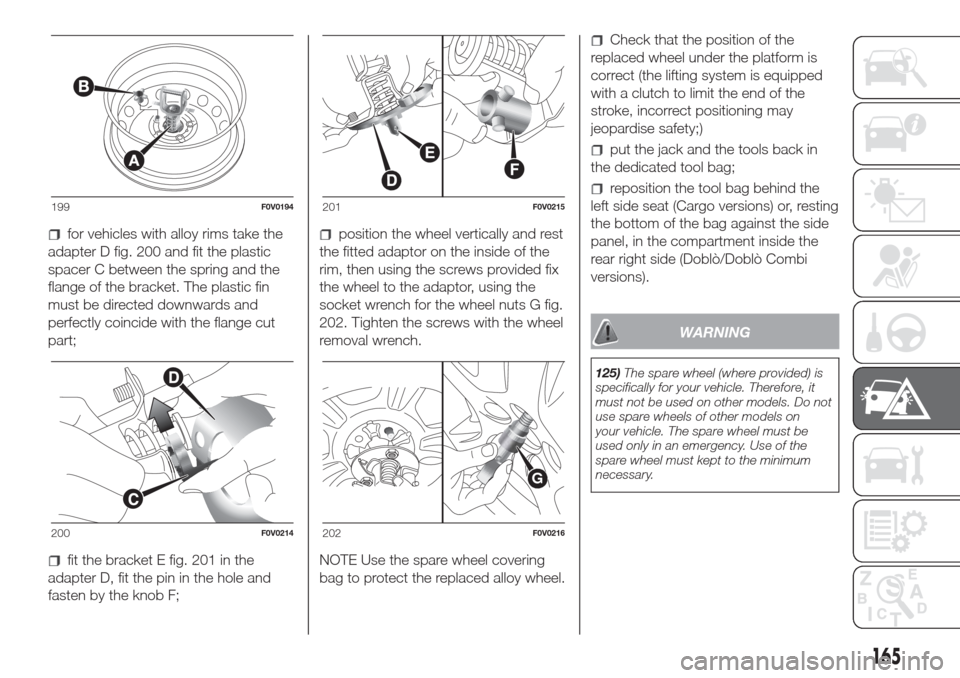
for vehicles with alloy rims take the
adapter D fig. 200 and fit the plastic
spacer C between the spring and the
flange of the bracket. The plastic fin
must be directed downwards and
perfectly coincide with the flange cut
part;
fit the bracket E fig. 201 in the
adapter D, fit the pin in the hole and
fasten by the knob F;
position the wheel vertically and rest
the fitted adaptor on the inside of the
rim, then using the screws provided fix
the wheel to the adaptor, using the
socket wrench for the wheel nuts G fig.
202. Tighten the screws with the wheel
removal wrench.
NOTE Use the spare wheel covering
bag to protect the replaced alloy wheel.
Check that the position of the
replaced wheel under the platform is
correct (the lifting system is equipped
with a clutch to limit the end of the
stroke, incorrect positioning may
jeopardise safety;)
put the jack and the tools back in
the dedicated tool bag;
reposition the tool bag behind the
left side seat (Cargo versions) or, resting
the bottom of the bag against the side
panel, in the compartment inside the
rear right side (Doblò/Doblò Combi
versions).
WARNING
125)The spare wheel (where provided) is
specifically for your vehicle. Therefore, it
must not be used on other models. Do not
use spare wheels of other models on
your vehicle. The spare wheel must be
used only in an emergency. Use of the
spare wheel must kept to the minimum
necessary.
199F0V0194
200F0V0214
201F0V0215
G
202F0V0216
165
Page 170 of 300
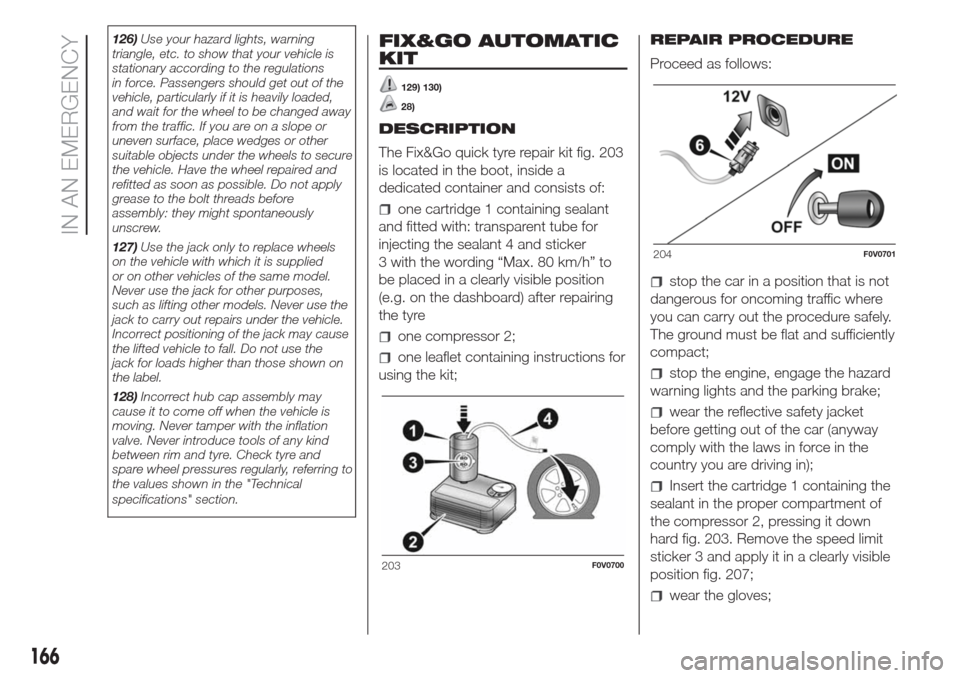
126)Use your hazard lights, warning
triangle, etc. to show that your vehicle is
stationary according to the regulations
in force. Passengers should get out of the
vehicle, particularly if it is heavily loaded,
and wait for the wheel to be changed away
from the traffic. If you are on a slope or
uneven surface, place wedges or other
suitable objects under the wheels to secure
the vehicle. Have the wheel repaired and
refitted as soon as possible. Do not apply
grease to the bolt threads before
assembly: they might spontaneously
unscrew.
127)Use the jack only to replace wheels
on the vehicle with which it is supplied
or on other vehicles of the same model.
Never use the jack for other purposes,
such as lifting other models. Never use the
jack to carry out repairs under the vehicle.
Incorrect positioning of the jack may cause
the lifted vehicle to fall. Do not use the
jack for loads higher than those shown on
the label.
128)Incorrect hub cap assembly may
cause it to come off when the vehicle is
moving. Never tamper with the inflation
valve. Never introduce tools of any kind
between rim and tyre. Check tyre and
spare wheel pressures regularly, referring to
the values shown in the "Technical
specifications" section.FIX&GO AUTOMATIC
KIT
129) 130)
28)
DESCRIPTION
The Fix&Go quick tyre repair kit fig. 203
is located in the boot, inside a
dedicated container and consists of:
one cartridge 1 containing sealant
and fitted with: transparent tube for
injecting the sealant 4 and sticker
3 with the wording “Max. 80 km/h” to
be placed in a clearly visible position
(e.g. on the dashboard) after repairing
the tyre
one compressor 2;
one leaflet containing instructions for
using the kit;REPAIR PROCEDURE
Proceed as follows:
stop the car in a position that is not
dangerous for oncoming traffic where
you can carry out the procedure safely.
The ground must be flat and sufficiently
compact;
stop the engine, engage the hazard
warning lights and the parking brake;
wear the reflective safety jacket
before getting out of the car (anyway
comply with the laws in force in the
country you are driving in);
Insert the cartridge 1 containing the
sealant in the proper compartment of
the compressor 2, pressing it down
hard fig. 203. Remove the speed limit
sticker 3 and apply it in a clearly visible
position fig. 207;
wear the gloves;
203F0V0700
204F0V0701
166
IN AN EMERGENCY
Page 203 of 300
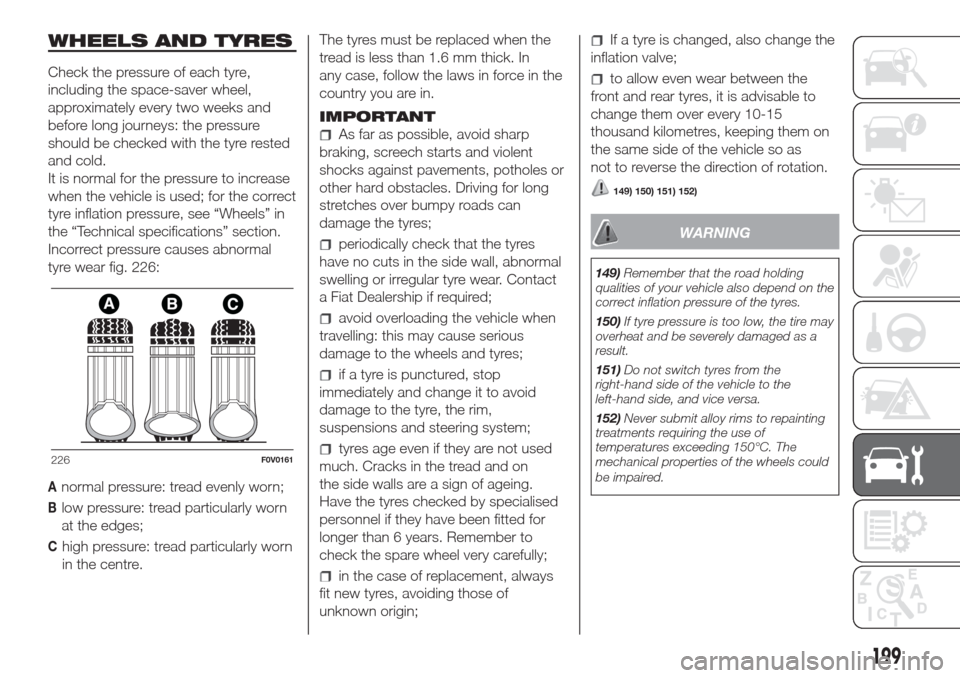
WHEELS AND TYRES
Check the pressure of each tyre,
including the space-saver wheel,
approximately every two weeks and
before long journeys: the pressure
should be checked with the tyre rested
and cold.
It is normal for the pressure to increase
when the vehicle is used; for the correct
tyre inflation pressure, see “Wheels” in
the “Technical specifications” section.
Incorrect pressure causes abnormal
tyre wear fig. 226:
Anormal pressure: tread evenly worn;
Blow pressure: tread particularly worn
at the edges;
Chigh pressure: tread particularly worn
in the centre.The tyres must be replaced when the
tread is less than 1.6 mm thick. In
any case, follow the laws in force in the
country you are in.
IMPORTANT
As far as possible, avoid sharp
braking, screech starts and violent
shocks against pavements, potholes or
other hard obstacles. Driving for long
stretches over bumpy roads can
damage the tyres;
periodically check that the tyres
have no cuts in the side wall, abnormal
swelling or irregular tyre wear. Contact
a Fiat Dealership if required;
avoid overloading the vehicle when
travelling: this may cause serious
damage to the wheels and tyres;
if a tyre is punctured, stop
immediately and change it to avoid
damage to the tyre, the rim,
suspensions and steering system;
tyres age even if they are not used
much. Cracks in the tread and on
the side walls are a sign of ageing.
Have the tyres checked by specialised
personnel if they have been fitted for
longer than 6 years. Remember to
check the spare wheel very carefully;
in the case of replacement, always
fit new tyres, avoiding those of
unknown origin;
If a tyre is changed, also change the
inflation valve;
to allow even wear between the
front and rear tyres, it is advisable to
change them over every 10-15
thousand kilometres, keeping them on
the same side of the vehicle so as
not to reverse the direction of rotation.
149) 150) 151) 152)
WARNING
149)Remember that the road holding
qualities of your vehicle also depend on the
correct inflation pressure of the tyres.
150)If tyre pressure is too low, the tire may
overheat and be severely damaged as a
result.
151)Do not switch tyres from the
righthand side of the vehicle to the
lefthand side, and vice versa.
152)Never submit alloy rims to repainting
treatments requiring the use of
temperatures exceeding 150°C. The
mechanical properties of the wheels could
be impaired.
226F0V0161
199
Page 219 of 300
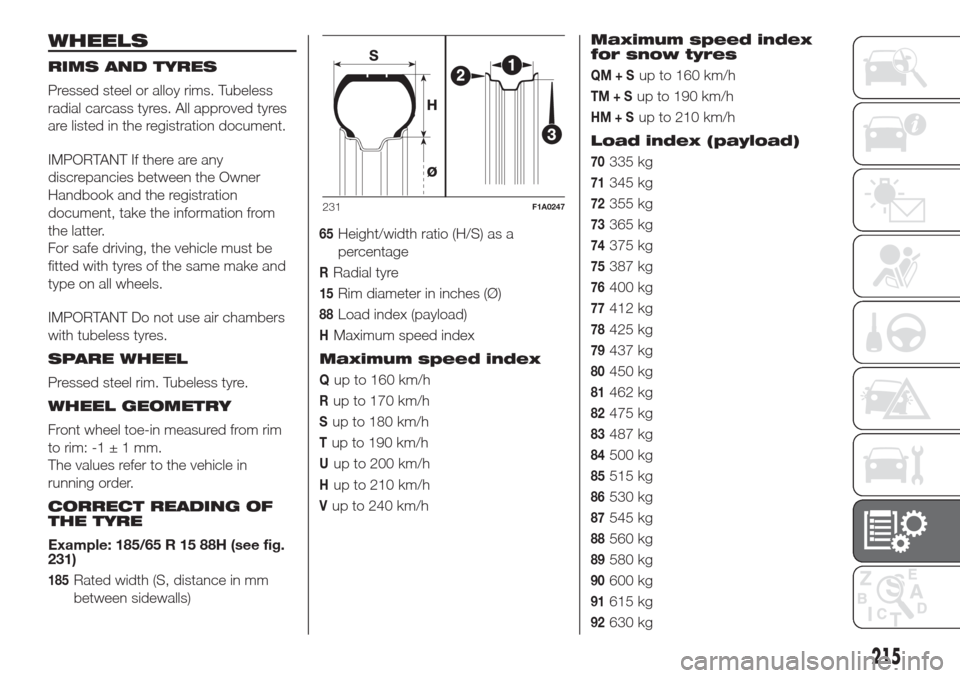
WHEELS
RIMS AND TYRES
Pressed steel or alloy rims. Tubeless
radial carcass tyres. All approved tyres
are listed in the registration document.
IMPORTANT If there are any
discrepancies between the Owner
Handbook and the registration
document, take the information from
the latter.
For safe driving, the vehicle must be
fitted with tyres of the same make and
type on all wheels.
IMPORTANT Do not use air chambers
with tubeless tyres.
SPARE WHEEL
Pressed steel rim. Tubeless tyre.
WHEEL GEOMETRY
Front wheel toe-in measured from rim
to rim: -1±1mm.
The values refer to the vehicle in
running order.
CORRECT READING OF
THE TYRE
Example: 185/65 R 15 88H (see fig.
231)
185Rated width (S, distance in mm
between sidewalls)
65Height/width ratio (H/S) as a
percentage
RRadial tyre
15Rim diameter in inches (Ø)
88Load index (payload)
HMaximum speed index
Maximum speed index
Qup to 160 km/h
Rup to 170 km/h
Sup to 180 km/h
Tup to 190 km/h
Uup to 200 km/h
Hup to 210 km/h
Vup to 240 km/hMaximum speed index
for snow tyres
QM+Sup to 160 km/h
TM+Sup to 190 km/h
HM+Sup to 210 km/h
Load index (payload)
70335 kg
71345 kg
72355 kg
73365 kg
74375 kg
75387 kg
76400 kg
77412 kg
78425 kg
79437 kg
80450 kg
81462 kg
82475 kg
83487 kg
84500 kg
85515 kg
86530 kg
87545 kg
88560 kg
89580 kg
90600 kg
91615 kg
92630 kg
231F1A0247
215
Page 221 of 300
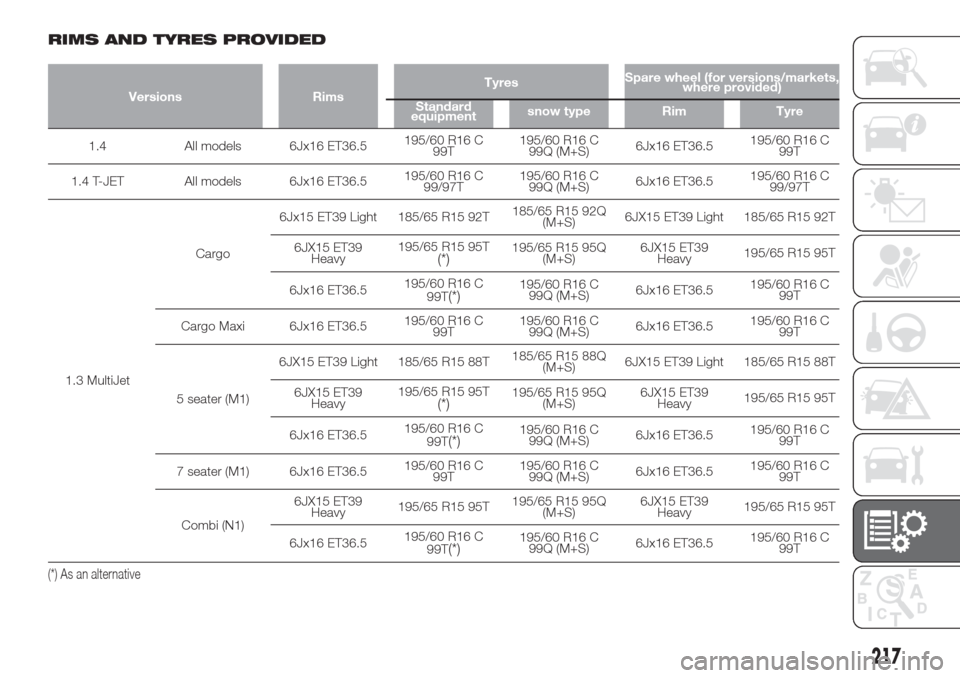
RIMS AND TYRES PROVIDED
Versions RimsTyresSpare wheel (for versions/markets,
where provided)
Standard
equipmentsnow type Rim Tyre
1.4 All models 6Jx16 ET36.5195/60 R16 C
99T195/60 R16 C
99Q (M+S)6Jx16 ET36.5195/60 R16 C
99T
1.4 T-JET All models 6Jx16 ET36.5195/60 R16 C
99/97T195/60 R16 C
99Q (M+S)6Jx16 ET36.5195/60 R16 C
99/97T
1.3 MultiJetCargo6Jx15 ET39 Light 185/65 R15 92T185/65 R15 92Q
(M+S)6JX15 ET39 Light 185/65 R15 92T
6JX15 ET39
Heavy195/65 R15 95T
(*)195/65 R15 95Q
(M+S)6JX15 ET39
Heavy195/65 R15 95T
6Jx16 ET36.5195/60 R16 C
99T
(*)195/60 R16 C
99Q (M+S)6Jx16 ET36.5195/60 R16 C
99T
Cargo Maxi 6Jx16 ET36.5195/60 R16 C
99T195/60 R16 C
99Q (M+S)6Jx16 ET36.5195/60 R16 C
99T
5 seater (M1)6JX15 ET39 Light 185/65 R15 88T185/65 R15 88Q
(M+S)6JX15 ET39 Light 185/65 R15 88T
6JX15 ET39
Heavy195/65 R15 95T
(*)195/65 R15 95Q
(M+S)6JX15 ET39
Heavy195/65 R15 95T
6Jx16 ET36.5195/60 R16 C
99T
(*)195/60 R16 C
99Q (M+S)6Jx16 ET36.5195/60 R16 C
99T
7 seater (M1) 6Jx16 ET36.5195/60 R16 C
99T195/60 R16 C
99Q (M+S)6Jx16 ET36.5195/60 R16 C
99T
Combi (N1)6JX15 ET39
Heavy195/65 R15 95T195/65 R15 95Q
(M+S)6JX15 ET39
Heavy195/65 R15 95T
6Jx16 ET36.5195/60 R16 C
99T
(*)195/60 R16 C
99Q (M+S)6Jx16 ET36.5195/60 R16 C
99T
(*) As an alternative
217
Page 222 of 300

Versions Rims TyresSpare wheel (for versions/markets,
where provided)
Standard
equipmentsnow type Rim Tyre
1.6 MultiJetCargo6JX15 ET39 Light 185/65 R15 92T185/65 R15 92Q
(M+S)6JX15 ET39 Light 185/65 R15 92T
6JX15 ET39
Heavy195/65 R15 95T
(*)195/65 R15 95Q
(M+S)6JX15 ET39
Heavy195/65 R15 95T
6Jx16 ET36.5195/60 R16 C
99T
(*)195/60 R16 C
99Q (M+S)6Jx16 ET36.5195/60 R16 C
99T
Cargo Maxi 6Jx16 ET36.5195/60 R16 C
99T195/60 R16 C
99Q (M+S)6Jx16 ET36.5195/60 R16 C
99T
5 seater (M1)6JX15 ET39 Light 185/65 R15 88T185/65 R15 88Q
(M+S)6Jx15 ET39 Light 185/65 R15 88T
6JX15 ET39
Heavy195/65 R15 95T
(*)195/65 R15 95Q
(M+S)6JX15 ET39
Heavy195/65 R15 95T
6Jx16 ET36.5195/60 R16 C
99T
(*)195/60 R16 C
99Q (M+S)6Jx16 ET36.5195/60 R16 C
99T
7 seater (M1) 6Jx16 ET36.5195/60 R16 C
99T195/60 R16 C
99Q (M+S)6Jx16 ET36.5195/60 R16 C
99T
Combi (N1)6JX15 ET39
Heavy195/65 R15 95T195/65 R15 95Q
(M+S)6JX15 ET39
Heavy195/65 R15 95T
6Jx16 ET36.5195/60 R16 C
99T
(*)195/60 R16 C
99Q (M+S)6Jx16 ET36.5195/60 R16 C
99T
2.0 MultiJet All models 6Jx16 ET36.5195/60 R16 C
99T195/60 R16 C
99Q (M+S)6Jx16 ET36.5195/60 R16 C
99T
(*) As an alternative
218
TECHNICAL DATA